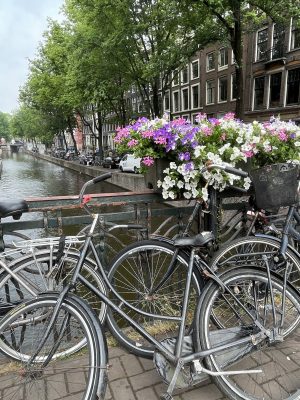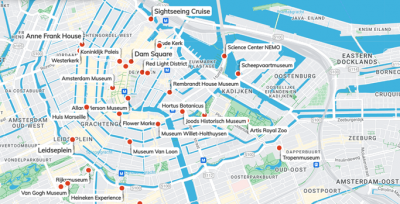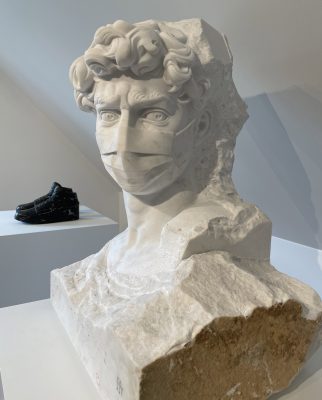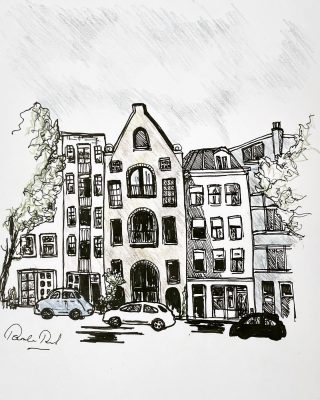 Amsterdam: bicycles, canals, flowers.
Amsterdam: bicycles, canals, flowers.
Amsterdam lives and breathes art. Home to some of the most significant art history, strolling this picturesque city is like stepping into a chocolate box cover. Streets are lined with charming, side-by-side “dancing houses”, flowers and hanging baskets everywhere, locals bustle on bicycles. Shopfronts are enticing, smart, quality, bakeries ooze colourful delights. Getting around is easy. If you’re not in the bicycling mix, the tram and bus systems are efficient.
 Map of Amsterdam and its canal belt lay-out
Map of Amsterdam and its canal belt lay-out
There are 100 kms of canals in Amsterdam, ambling around this relatively small city. A canal trip is a ‘must’, as only from the water can you fully appreciate Amsterdam’s fascination. Like the on-off buses in other European cities, the skipper of your canal journey tells the history, pointing out places of interest, architectural features. You can also do a cycling guided tour around the city. The streets of Amsterdam follow the canal belt as if curling around and around. A look at the city’s map highlights its cultural cornucopia that includes the Rijksmuseum, MOCO museum, Van Gogh Museum, a Da Vinci Interactive experience as well as a Lumières of Dali & Gaudi, Ann Frank House and other historical museums, and a tour of the Royal Palace. For something a little different there’s an Upside Down museum, a Ripley’s Believe It or Not museum, the WONDR Immersive Playground, a Madame Tussauds. Being Holland, there is (of course) a Red Lights’ Secrets visit and a Cannabis Museum.






Photos: the Rijksmuseum; cyclists and bicycles are everywhere: MOCO Museum “In Art We Trust” on exterior windows; where art and history abound; looking along one of many canals.
On my recent trip, with so much ‘old and new’ art on show, I firstly visited MOCO Museum (the Modern and Contemporary Museum) where there are lots of favourite artists, plus some discoveries.
The Kid: a self-taught artist, The Kid’s large works address social and political themes facing today’s youth. His creative style is described as ‘hyper-realism’, painting, portraiture, photography, created collage-like. I also enjoyed Nadia Haddad and Studio Irma’s exhibits.





Photos: Art by The Kid. “I Saw the Sun Begin to Dim” uses Pinocchio to represent seeking identity; Nadiya Haddad “I wear my tattoos as a symbol of my own battles”; Studio Irma’s “Diamond Matrix” experience feels like stepping inside a kaleidoscope.
What a stellar line-up at MOCO!






Photos: Kaws, Damien Hirst, Banksy, Keith Haring, Yayo Kusama.
Francesco Filiberto Tonarelli’s marble sculpture “David 19” (2021) has the appearance of a Renaissance work, with a pandemic reference.

David 19 – Francesco Filiberto Tonarelli
MOCO is open daily from 9am-8pm. website The world of Moco (mocomuseum.com)
The Rijksmuseum is breathtaking on approach. It houses more than 8,000 Dutch and European works of art, covering 800 years of history. Here is the place to see all those 17th Century Dutch Masters studied at school – Rembrandt, Vermeer, Frans Hals – as well as the Dutch post-impressionists and more recent artists.






Photos: Around the interior of The Rijksmuseum; Johannes Vermeer’s “Girl with a Red Hat”, “The Milkmaid” and “Houses in Delft” aka “The Little Street”.
Here’s a sampling of other artists whose works are in The Rijksmuseum:
Vincent Van Gogh is there although as mentioned, there is a Van Gogh Museum in Amsterdam. While he was born in Zundert, Vincent Van Gogh spent most of his creative life in France. His works are possibly the most widely-known of all Dutch painters.
Willem Claesz, one of the principal Dutch Baroque still life painters.
Ludolf Backhuysen was born in Germany, but studied under Dutch artists and remained in the Netherlands until his death. He was known for his seascape themes.
Judith Leyster painted during the “Dutch Golden Age” 1580s-1672, a time when the Netherlands’ trade, scientific developments, art was thriving throughout Europe. At that time, her work was highly regarded, but after her death, Leyster’s work was attributed to Frans Hals or her artist husband, Jan Miense Molenaer. It wasn’t until the late 1800s that scholars attributed her name as the artist.
Another female artist, Thérèse Schwartze, was born in Amsterdam. Her father, also a painter, provided her early training. She went on to study at Amsterdam’s State Academy of Fine Arts.
I was struck by Dirck van Baburen’s gruesome painting “Prosmethus” depicting a Greco-Roman mythology story where Mercury watches the god Vulcan punish bold and cunning Titan, Prometheus, for stealing fire from the gods and giving it to mortals. Prometheus’s punishment is to be bound to a rock and to have his liver consumed daily by an eagle!






Photos: Van Gogh’s self portrait; (detail) “Still Life with a Gilt Cup” by Willem Claesz; “A Seascape with Figures by a boat on a shore” Ludolf Bakhuysen; Judith Leyster’s “The Merry Drinker”; Self-portrait Thérèse Schwartze; (detail) from “Prosthemus” by Dirck van Baburen.
Of all the Dutch Masters, Rembrandt van Rijn is considered by many as the most important. Art students today are taught the step-by-step of painting like Rembrandt, to understand those techniques for paint mixing, application, portraiture. His works and structure are endlessly learned and explored. Since 2019, the Rijksmuseum has publicly undertaken the largest ever conservation study of an artwork, Rembrandts’ Operation Night Watch (1642). Their process zooms in to the smallest detail, creates 3D scans, examines the layers, paint, effects of vibration on the 380 year old canvas. Information regarding the results of this research is on Results of the research (rijksmuseum.nl)




Photos: Rembrandt’s The Syndics (1662); educational information on Rembrandt; research project on Operation Night Watch.
The Rijksmuseum is open daily 10am-5pm https://www.rijksmuseum.nl
At home in Holland
It’s 50 years since I lived in Holland. Returning in 2023 put a big smile on my face, familiar sights, the welcoming sounds of Nederlandse spraaker.
I left England on a ghastly overnight Hull to Rotterdam crossing, where the ferry heaved through the North Sea, the stench of vomit everywhere, and the ‘kitchen’ didn’t reopen for a much-needed cuppa until 9am. I arrived with a suitcase, my flight ticket home to Melbourne and £8! My boyfriend had gone ahead to organise our accommodation and had secured a job as Lighting Director at the Circustheater in Scheveningen, Den Haag. Business in The Hague was almost entirely embassies and petroleum industry. Secretarial office work was in demand, Australians had a good reputation and I was placed at ARAMCO (Arabian American Oil Co) on my first day. To secure my visa and stay, I had to hand my flight ticket over to Police/Customs officials at the Stadhuis. They held onto that ticket until I advised I was leaving. My ticket was returned and my visa status changed to the date of flight booked.
What fun it was for a girl living in Holland in the ’70s. I made friends who remain close and I still see. Work life was easy, bars were vibrant, serving saté and bitterballen as bar snacks. The Brain Box had chocolate carpet on the floor, walls and ceiling, with a large table of cheese selection. Waitresses at the Playboy bar wore black leotards with bunny ears (I danced a lot to Lady Marmalade’s Voulez-vous choucez avec moi?). Friday nights at the British ex-pats club was wine and playing darts.
I fell in love (again) and moved into van Leeuwenhoekstraat with Karin (Dutch, but had grown-up with her family in Uganda), René (Dutch), Mimi (Swiss-French) and Patrick (Irish). Our own little ‘league of nations’. Many happy memories. One snow-filled night, I sat on the back of Patrick’s bicycle, carrying a flagon of red wine home. I did Joke’s weekly Jazz Ballet classes, and can still remember the first ‘travelling’ steps to “Rock the Boat” (The Hues Corporation).
The Pable Jazz Festival was the best music concert I have ever been to. First two hours commenced with Oscar Peterson, he was joined on stage by Milt Jackson, Joe Pass, Louie Bellson, Dizzy Gillespie and more. Second half, another two hours of Count Basie, a big brass blast and ELLA FITZGERALD!!






Photos from Den Haag: fun in my Fiorucci flares; local cheese vender; Scheveningen beach with René and Karin; jazz ballet teacher Joke; ticket and program from the Pablo Jazz Festival; on van Leeuwenhoekstraat.

“Dancing Houses” of Amsterdam (ink pen and colour pencil) 2023
© Photos and text Pamela Reid 2024